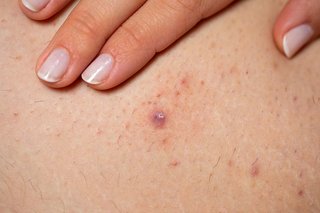Ingrown hairs can look like raised, itchy bumps on the skin.
On white skin the bumps may look red. Redness may be harder to see on black or brown skin, but they may look a different color to the surrounding skin.
Sometimes one can see a hair trapped under the skin.
One is more likely to have ingrown hairs if one has coarse or curly hair.

Infected ingrown hairs can be painful. Pus may also be seen.
Waxing, plucking and threading hair can also lead to ingrown hairs. Areas most common for ingrown hair include: the face and neck, legs, armpits, chest, back, pubic region.
The best way to prevent ingrown hairs is by not shaving.
If one wishes to shave, or remove hair in another way, there are things to do to prevent ingrown hairs and help them get better quicker.
Do
wet your skin with warm water and use shaving gel
shave in the direction the hairs are growing
use as few strokes of the razor as possible
rinse the razor after every stroke
hold a cool, wet cloth to your skin after shaving to reduce irritation
use an exfoliating scrub to help release any trapped hairs
try a different hair removal method, such as hair removal cream
try a long-term way of removing hair, such as laser treatment
Don’t
do not shave too close – leaving some stubble can stop bacteria getting in
do not use a blunt razor
shave every other day if possible
do not scratch, pick or squeeze ingrown hairs as this can damage your skin and lead to infection
A pharmacist can help with ingrown hairs
- creams and lotions to help itching
- shaving and hair removal products to help prevent irritation
- exfoliating products to help prevent ingrown hairs
- a mild antiseptic to help prevent infection


